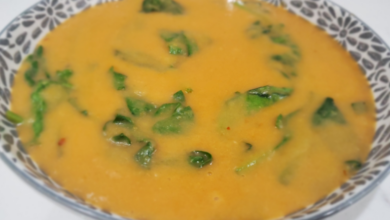
Tomato Lentil Soup: A Comforting Classic
Tomato lentil soup, a culinary staple in countless cultures, has been warming hearts and bellies for centuries. This hearty, flavorful soup is a testament to the ingenuity of our ancestors, who discovered the magic of combining simple ingredients to create a satisfying and nutritious meal.
From humble beginnings, tomato lentil soup has evolved into a global phenomenon, adapting to regional tastes and culinary traditions.
Whether simmered on a stovetop or whipped up in a pressure cooker, tomato lentil soup offers a comforting embrace, its aroma filling the kitchen with warmth and inviting you to gather around the table. Its versatility is unmatched, accommodating a wide range of dietary needs and preferences.
From vegan and vegetarian variations to those enriched with meat or poultry, tomato lentil soup is a dish that can be tailored to suit every palate.
History and Origins
Tomato lentil soup, a hearty and flavorful dish, has a rich history that spans continents and cultures. Its origins can be traced back to ancient times, with evidence suggesting that lentils and tomatoes have been enjoyed separately for centuries.
Early History of Lentils and Tomatoes
Lentils, a staple food in many ancient civilizations, have been cultivated for over 10,000 years. Archaeological evidence suggests that lentils were grown in the Near East and the Mediterranean region as early as the Neolithic period. They were a significant source of protein and fiber for ancient populations.
Tomatoes, on the other hand, originated in the Andes region of South America. They were first domesticated by the indigenous people of Mexico and Central America and were later introduced to Europe by Spanish explorers in the 16th century.
The Rise of Tomato Lentil Soup
The combination of lentils and tomatoes into a soup is believed to have originated in the Mediterranean region, likely in Italy or the Middle East. This fusion of ingredients likely occurred as a result of trade and cultural exchange between these regions.
The exact origins of the dish are difficult to pinpoint, but it is believed to have evolved over time as different cultures adopted and adapted the recipe.
Cultural Significance of Tomato Lentil Soup
Tomato lentil soup has become a beloved dish in many cultures around the world. It is often served as a comforting and nutritious meal, particularly during colder months. In Italy, for instance, a similar soup known as “minestra di lenticchie” is a traditional dish, often served with pasta or bread.
In the Middle East, a similar soup known as “adass” is a popular vegetarian dish, often flavored with cumin, turmeric, and other spices.
Nutritional Value and Benefits
Tomato lentil soup is a hearty and nutritious dish that packs a punch of essential vitamins, minerals, and fiber. This soup is a true nutritional powerhouse, offering a variety of health benefits.
Nutritional Composition
The nutritional composition of tomato lentil soup varies slightly depending on the recipe and ingredients used. However, a typical serving of tomato lentil soup provides a good source of:
- Protein: Lentils are an excellent source of plant-based protein, contributing to muscle growth and repair, satiety, and overall health.
- Fiber: Both lentils and tomatoes are high in fiber, promoting digestive health, regulating blood sugar levels, and lowering cholesterol.
- Vitamins: Tomato lentil soup is rich in vitamins A, C, and K, which are essential for immune function, skin health, and bone strength.
- Minerals: This soup is also a good source of minerals like iron, potassium, and magnesium, crucial for red blood cell production, blood pressure regulation, and muscle function.
Health Benefits
The nutritional profile of tomato lentil soup translates into several health benefits.
- Heart Health: The high fiber content and potassium in tomato lentil soup can help lower blood pressure and cholesterol levels, reducing the risk of heart disease.
- Blood Sugar Control: The fiber in lentils helps regulate blood sugar levels, making this soup a good choice for people with diabetes or those looking to manage their blood sugar.
- Weight Management: Tomato lentil soup is low in calories and high in fiber, which can help promote feelings of fullness and reduce overall calorie intake, aiding in weight management.
- Improved Digestion: The fiber in this soup promotes healthy digestion and can help prevent constipation.
- Antioxidant Benefits: Tomatoes are rich in lycopene, a powerful antioxidant that protects against cell damage and may reduce the risk of certain cancers.
Comparison with Other Soups
Compared to other soups, tomato lentil soup stands out for its high protein and fiber content. For instance, chicken noodle soup is lower in protein and fiber, while creamy tomato soup is often higher in calories and fat.
Ingredients and Variations
Tomato lentil soup is a hearty and flavorful dish that can be customized to suit individual preferences. The basic ingredients are simple and readily available, but there are endless possibilities for variations, making it a versatile recipe.
Common Ingredients
The core ingredients of tomato lentil soup are tomatoes, lentils, and broth. These ingredients provide the foundation for the soup’s flavor and texture.
- Tomatoes: The primary source of flavor and acidity in tomato lentil soup. They can be used fresh, canned, or even in the form of tomato paste or purée.
- Lentils: Lentils are a type of legume that adds protein, fiber, and a hearty texture to the soup. Green lentils are commonly used, but other varieties, such as brown or red lentils, can also be substituted.
- Broth: Broth provides the base for the soup and adds additional flavor. Vegetable broth is the most common choice, but chicken or beef broth can also be used.
In addition to the core ingredients, various other ingredients can be added to enhance the flavor and texture of tomato lentil soup.
- Vegetables: Carrots, celery, onions, and garlic are frequently added to tomato lentil soup. They provide sweetness, depth of flavor, and additional nutrients.
- Herbs and Spices: Herbs like basil, oregano, thyme, and rosemary, along with spices like cumin, coriander, and turmeric, add complexity and aroma to the soup.
- Other Additions: Some variations include ingredients like rice, quinoa, or pasta for added texture and carbohydrates.
Variations of Tomato Lentil Soup
Tomato lentil soup is a global dish with variations across different regions and cultures. These variations often reflect the local ingredients and culinary traditions.
- Indian Dal: A popular variation of tomato lentil soup in India, where it is known as dal. It often includes spices like turmeric, cumin, coriander, and chili powder, along with vegetables like onions, garlic, and ginger.
- Mediterranean Tomato Lentil Soup: This variation features ingredients like chickpeas, lemon juice, and fresh herbs like parsley and mint.
- French Lentille à la Française: This French version is typically made with brown lentils, carrots, celery, onions, and a bouquet garni. It is often served with a dollop of crème fraîche or yogurt.
Popular Variations of Tomato Lentil Soup
Here is a table showcasing some popular variations of tomato lentil soup, along with their key ingredients and unique characteristics:
| Variation | Key Ingredients | Unique Characteristics |
|---|---|---|
| Classic Tomato Lentil Soup | Tomatoes, lentils, broth, carrots, celery, onions, garlic, herbs (basil, oregano), spices (cumin, coriander) | Simple and hearty, with a balanced flavor profile. |
| Spicy Tomato Lentil Soup | Tomatoes, lentils, broth, carrots, celery, onions, garlic, herbs (basil, oregano), spices (cumin, coriander, chili powder, cayenne pepper) | A bolder flavor profile with a kick of heat. |
| Curried Tomato Lentil Soup | Tomatoes, lentils, broth, carrots, celery, onions, garlic, herbs (curry leaves, cilantro), spices (turmeric, cumin, coriander, garam masala) | Inspired by Indian cuisine, with a fragrant and flavorful curry base. |
| Creamy Tomato Lentil Soup | Tomatoes, lentils, broth, carrots, celery, onions, garlic, herbs (basil, oregano), spices (cumin, coriander), coconut milk | A rich and creamy texture with a hint of sweetness. |
Preparation and Cooking Techniques
Tomato lentil soup is a versatile dish that can be prepared in various ways, each yielding a unique flavor and texture. Whether you prefer a quick weeknight meal or a slow-cooked, hearty stew, there’s a method to suit your preferences and time constraints.
Simmering
Simmering is a classic technique for preparing tomato lentil soup, allowing the flavors to meld and the lentils to soften gently. It involves cooking the soup over low heat, ensuring a slow and steady simmer. Here are the steps involved in simmering tomato lentil soup:
- Sauté the aromatics:Start by sautéing chopped onions, garlic, and celery in olive oil until softened. This step enhances the base flavor of the soup.
- Add lentils and broth:Pour in the lentils, vegetable broth, and tomato purée. Bring the mixture to a boil, then reduce heat and simmer for 20-30 minutes, or until the lentils are tender.
- Season and simmer further:Season the soup with salt, pepper, and any additional herbs or spices. Continue simmering for another 10-15 minutes to allow the flavors to develop.
- Blend for desired consistency:Use an immersion blender or transfer the soup to a regular blender to achieve the desired consistency. For a smooth soup, blend until completely smooth. For a chunkier texture, blend partially.
Pressure Cooking
Pressure cooking is a time-saving technique that utilizes high pressure to cook food quickly. This method is ideal for busy weeknights or when you need a fast and flavorful soup.
- Sauté the aromatics:Similar to simmering, start by sautéing chopped onions, garlic, and celery in olive oil until softened.
- Add lentils and broth:Pour in the lentils, vegetable broth, and tomato purée.
- Pressure cook:Secure the pressure cooker lid and cook according to the manufacturer’s instructions. Typically, lentil soup cooks in 10-15 minutes under pressure.
- Natural release:After cooking, allow the pressure to release naturally for 10-15 minutes before opening the lid. This ensures the lentils are fully cooked and prevents splattering.
- Season and blend:Season the soup with salt, pepper, and any additional herbs or spices. Use an immersion blender or regular blender to achieve the desired consistency.
Slow Cooking
Slow cooking is a technique that involves cooking food at low temperatures for extended periods, resulting in tender and flavorful dishes. It’s a great method for tomato lentil soup, as it allows the flavors to meld and the lentils to become exceptionally soft.
- Sauté the aromatics:Start by sautéing chopped onions, garlic, and celery in olive oil until softened.
- Transfer to slow cooker:Pour the sautéed aromatics into a slow cooker. Add the lentils, vegetable broth, tomato purée, and any additional herbs or spices.
- Slow cook:Cook on low heat for 6-8 hours, or on high heat for 3-4 hours. The longer you cook the soup, the more tender the lentils will become.
- Blend for desired consistency:Use an immersion blender or regular blender to achieve the desired consistency.
Tips and Tricks, Tomato lentil soup
- Use high-quality broth:A good vegetable broth will make a significant difference in the flavor of your soup.
- Add acidity:A squeeze of lemon juice or a splash of red wine vinegar can brighten the flavor of the soup.
- Don’t overcook the lentils:Overcooked lentils can become mushy. Aim for tender but still slightly firm lentils.
- Adjust seasoning:Taste the soup throughout the cooking process and adjust seasoning as needed.
- Garnish:Top your soup with fresh herbs, a dollop of yogurt, or a drizzle of olive oil for added flavor and visual appeal.
Serving Suggestions and Pairings

Tomato lentil soup, a hearty and flavorful dish, can be enjoyed in various ways, making it a versatile culinary creation. Serving this soup is an art form, and mastering it allows you to create an unforgettable dining experience.
Serving Styles and Accompaniments
Serving styles and accompaniments play a crucial role in enhancing the enjoyment of tomato lentil soup. Here’s a table highlighting different serving styles and their accompanying elements:| Serving Style | Accompaniments | Toppings | Side Dishes ||—|—|—|—|| Classic Bowl| Crusty bread, grilled cheese sandwich | Fresh parsley, a dollop of yogurt | Green salad with vinaigrette dressing || Bread Bowl| | Shredded cheese, toasted croutons | Mixed greens with a light balsamic dressing || Soup Shooter| | | || Soup Dumpling| | | || Soup with a Twist| | | |
Ideal Serving Temperature
The ideal serving temperature for tomato lentil soup is warm but not hot. Serving it at a temperature between 140°F and 160°F allows the flavors to fully develop while maintaining its optimal texture. If the soup is too hot, the flavors can become overpowering, and the lentils may become mushy.
On the other hand, serving it cold will not allow the flavors to fully bloom.
Beverage and Food Pairings
Tomato lentil soup pairs well with a variety of beverages and food items. The soup’s savory and slightly tangy flavor profile complements a range of tastes. Here are some suggestions for pairing:* Beverages:
White Wine A dry white wine, such as Sauvignon Blanc or Pinot Grigio, can cut through the richness of the soup and provide a refreshing contrast.
Red Wine A light-bodied red wine, such as Beaujolais or Pinot Noir, can enhance the earthy flavors of the lentils.
Beer
Tomato lentil soup is a hearty and satisfying meal, perfect for chilly evenings. It’s also a great way to incorporate plenty of protein and fiber into your diet, both of which are crucial for weight management. If you’re looking for more tips on how to make healthy choices that lead to sustainable weight loss, check out this article on 10 Simple Changes That Lead to Weight Loss.
After incorporating some of these changes, you can enjoy a comforting bowl of tomato lentil soup guilt-free!
Tomato lentil soup is a classic comfort food that’s packed with flavor and nutrients. But did you know it’s also a fantastic choice for weight loss? Lentils are a powerhouse of fiber, which is essential for feeling full and satisfied after meals.
If you’re looking to incorporate more high-fiber meals into your diet, check out this guide on High Fiber Meals for Weight Loss: A Guide to Feeling Full and Slim. You’ll find plenty of delicious and healthy recipes, including more fiber-rich soup ideas that are perfect for weight management.
Water A simple glass of water can cleanse the palate and enhance the soup’s flavors.* Food Pairings:
Salads A light salad with a vinaigrette dressing can provide a refreshing contrast to the soup’s richness.
Grilled Cheese Sandwich The combination of tomato lentil soup and a grilled cheese sandwich is a classic comfort food pairing.
Roasted Vegetables Roasted vegetables, such as carrots, broccoli, or asparagus, can complement the soup’s earthy flavors.
Bread A crusty bread, such as sourdough or baguette, can be used to soak up the soup’s flavorful broth.
Cultural and Culinary Significance
Tomato lentil soup, a hearty and flavorful dish, transcends geographical boundaries and holds a special place in diverse culinary traditions around the world. Its humble origins and adaptable nature have led to its widespread adoption and cultural significance, reflecting the ingenuity and resourcefulness of people across different cultures.
Variations in Tomato Lentil Soup
Tomato lentil soup, a versatile dish, undergoes fascinating transformations as it travels across cultures, acquiring unique ingredients, preparation methods, and serving customs. These variations not only reflect local culinary preferences but also highlight the adaptability of this simple yet satisfying soup.
Tomato lentil soup is a hearty and comforting meal, perfect for a chilly evening. It’s also packed with fiber and protein, which can help you feel full and satisfied. But did you know that managing your hormones can also play a crucial role in weight loss?
If you’re looking to shed a few pounds, it’s worth understanding the role of hormones like leptin, ghrelin, and insulin, as explained in this insightful article: 3 Hormones to Keep in Mind for Weight Loss. By optimizing your hormonal balance, you can boost your metabolism and make those weight loss goals a reality.
And remember, a delicious bowl of tomato lentil soup can be a tasty and healthy addition to any weight management plan.
| Region | Unique Ingredients | Preparation Methods | Serving Customs |
|---|---|---|---|
| Mediterranean | Olive oil, oregano, lemon juice, feta cheese | Simmered with aromatic vegetables and herbs, often served with a dollop of yogurt or a sprinkle of feta cheese. | Enjoyed as a light meal or a starter, sometimes accompanied by crusty bread. |
| Indian | Spices like turmeric, cumin, coriander, and garam masala, ginger, garlic, coconut milk | Prepared with a blend of aromatic spices and often includes coconut milk for a creamy texture. | Served with rice or roti, often as a comforting meal. |
| French | Carrots, celery, onions, thyme, bay leaf, sometimes bacon or ham | Prepared with a classic French mirepoix (carrots, celery, and onions), often with the addition of bacon or ham. | Served with crusty bread or a side of salad, often as a simple and satisfying meal. |
| Eastern European | Sour cream, dill, smoked sausage, sometimes paprika | Often includes smoked sausage and is flavored with dill and paprika. | Served with a dollop of sour cream or a sprinkle of dill, often as a hearty and comforting meal. |
Tomato Lentil Soup in Contemporary Cuisine
Tomato lentil soup has transcended its traditional roots, finding a prominent place in contemporary culinary landscapes. From bustling restaurant kitchens to home cooks’ kitchens, this humble dish continues to evolve and captivate taste buds with its versatility and comforting warmth.
Innovative Interpretations and Presentation Styles
Contemporary chefs have embraced tomato lentil soup as a canvas for culinary creativity, infusing it with bold flavors and unexpected textures.
- Flavor Infusions:Spiced tomato lentil soups, incorporating ingredients like smoked paprika, cumin, or curry powder, add depth and complexity to the classic recipe.
- Texture Variations:Chefs have experimented with the texture of tomato lentil soup, incorporating elements like crispy fried onions, toasted bread croutons, or creamy coconut milk for a multi-sensory experience.
- Modern Presentation:The presentation of tomato lentil soup has also undergone a transformation, with chefs showcasing it in elegant bowls, garnished with fresh herbs, microgreens, or a swirl of flavorful oil.
Examples of Chef Innovations
Several renowned chefs have incorporated tomato lentil soup into their signature dishes or menus, showcasing its adaptability and versatility.
- Chef Daniel Humm, of Eleven Madison Park in New York City, has created a sophisticated version of tomato lentil soup with black truffle oil and toasted bread croutons, elevating the dish to a new level of refinement.
- Chef Alice Waters, known for her farm-to-table philosophy, has championed a simple and rustic version of tomato lentil soup, emphasizing the purity of fresh, seasonal ingredients.
- Chef David Chang, founder of Momofuku, has incorporated tomato lentil soup into his innovative Asian-inspired dishes, showcasing its versatility and adaptability to diverse culinary traditions.
Summary
So, the next time you’re seeking a soul-satisfying meal that’s both delicious and good for you, consider embracing the timeless allure of tomato lentil soup. Its rich history, nutritional value, and culinary adaptability make it a dish that transcends generations, offering a comforting escape from the everyday and a reminder of the simple pleasures that bring us together.






